
To obtain high-resolution stamp images for media use only, email: mark.v.reynolds@usps.gov
CHICAGO — The Postal Service cooked up a feast of 20 million Limited Edition Celebrity Chefs Forever stamps today. The sugar-free, fat-free, zero-calorie stamps will be on the menu of the nation’s Post Offices beginning today.
The five chefs honored on the stamps — James Beard, Julia Child, Joyce Chen, Edna Lewis and Edward (Felipe) Rojas-Lombardi — revolutionized the nation’s understanding of food. By integrating international ingredients and recipes with American cooking techniques and influence, these chefs introduced new foods and flavors to the American culture.
“These chefs invited us to feast on regional and international flavors and were early — and ardent — champions of trends that many foodies now take for granted,” said U.S. Postal Service Entry Mail and Payment Technology Vice President Pritha Mehra in dedicating the stamps.
Mehra is the owner of the Mystic Kitchen cooking school where she teaches the art of Indian cooking to students throughout the Washington, D.C. metropolitan area.
“As they shared their know-how, they encouraged us to undertake our own culinary adventures, and American kitchens have never been the same since. That is why today, we are celebrating not only five celebrity chefs, but also the unique flavors and dishes that — thanks to them — have become American staples,” she added.
Joining Mehra in the dedication were “ Chewing the Fat ” podcast hosts Monica Eng and Louisa Chu; winner of Top Chef and Founder/Owner of Girl & the Goat and Little Goat restaurantsStephanie Izard; Illinois Restaurant Association President and CEO Sam Toia; and U.S. Postal Service Chicago Acting District Manager Greg Johnson.
“This line up of culinary greats has been recognized over the years within our community for having such an impact on the industry as a whole,” said Izard. “To now see this group being celebrated by the U.S. Postal Service through a special line of stamps is very exciting because it showcases the culinary world to everyone. Knowing that people outside of the industry are becoming more interested in not just great food, but in the influencers that have helped shape the world of food, restaurants and cooking that we have today, is truly remarkable.”
Special guests included James Beard Foundation Sponsorship Director Yvon Ros; Joyce Chen’s son Stephen Chen; Edna Lewis’ sister Ruth Lewis Smith; and Edna Lewis’ son Dr. Afeworki Paulos.
The dedication ceremony took place at the Park Grill in Chicago to kick off the Chicago Gourmet food and wine celebration. The ceremony pays tribute to the five chefs by showcasing their most iconic dishes while revealing the new additions to the Forever stamps series.
The stamps feature digital illustrations by Jason Seiler of Chicago, depicting the chefs in a style intended to resemble oil paintings. Art director Greg Breeding of Charlottesville, VA, designed the stamps.
Available in a pane of 20, the stamps may be purchasednow at usps.com/stamps, at 800-STAMP24 (800-782-6724) and on eBay at ebay.com/stampsfor delivery shortly after Sept. 26.
The five chefs are being recognized for inspiring the American public to expand its collective palates.
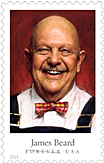
Anointed the “Dean of American cookery” by the New York Times in 1954, James Beard (1903–1985) laid the groundwork for the food revolution that has put America at the forefront of global gastronomy. He was a pioneer foodie, host of the first food program on the fledgling medium of television in 1946, the first to suspect that classic American culinary traditions might cohere into a national cuisine, and an early champion of local products and markets. Beard nurtured a generation of American chefs and cookbook authors who have changed the way we eat.
During World War II, he served with the United Seamen’s Service, further developing his culinary and organizational skills by setting up clubs and canteens for merchant seamen in Puerto Rico, Brazil, Panama and France. When he returned to New York City in 1945, the local NBC station asked him to appear on the new medium of television. He jumped at the chance, appearing weekly in “Elsie Presents James Beard in ‘I Love to Eat,’” sponsored by Borden.
In the years following, Beard appeared on television and wrote for such magazines as Gourmet and House and Garden. In 1955, he began a three-decade career as a teacher when he established the James Beard Cooking School.
From the 1950s onward, Beard became a sought-after restaurant consultant and commercial endorser while writing numerous books about cooking, entertaining and food. In 1952, he co-authored a guide to the restaurants of Paris, and in 1954 he published a guide to entertaining guests, “How to Eat Better for Less Money,”and a book about cooking fish — which covered not only 80 species of fish and shellfish, but also frogs, turtles and snails. In 1959, “The James Beard Cookbook,” a low-cost paperback for beginners or aspiring cooks in need of improvement, earned praise from Craig Claiborne of the New York Times, who dubbed Beard a “kitchen wizard.”
After his death in 1985, his colleagues and friends established the James Beard Foundation and made his Greenwich Village house a site for food-related events. The James Beard Foundation Awards recognize excellence in the food and beverage industries, and the foundation’s scholarship program has given more than $3.5 million in cash and tuition wavers to talented students. An annual James Beard food conference began in 2010, accompanied in 2011 by the James Beard Foundation Leadership Awards, an apt way to honor the gastronome that set American cooking on its way.

Joyce Chen (1917–1994) is one of America’s most well-known promoters of Chinese food. From her landmark restaurant in the Boston area to her cookbooks and trailblazing PBS television show, Chen invited newcomers to sample unfamiliar dishes in ways that firmly established Chinese cuisine in the United States.
From her landmark restaurants in the Boston area to her cookbooks and trailblazing PBS television show, Chen invited newcomers to sample unfamiliar dishes in ways that firmly established Chinese cuisine in the United States.
Chen was born in Beijing, China, where her father, a railroad administrator and city executive, employed an excellent family chef. After overseeing a successful banquet when she was 18, Chen became eager to learn more about cooking and food. After the Chinese Revolution in 1949, Chen left China and found herself in Cambridge, MA, where Chinese students from local universities would visit her family for meals — and to enjoy a rare taste of home.
In 1958, Chen opened her first restaurant in Cambridge, MA. At a time when even soy sauce was considered exotic in America, Chen introduced many Northeasterners to such dishes as Peking duck, moo shu pork and hot-and-sour soup, often serving Chinese food buffet-style, at first alongside familiar Western dishes so nervous patrons could comfortably sample new things.
In 1962, two years after teaching Chinese cooking classes with long waiting lists, Chen compiled her recipes and kitchen tips into the “Joyce Chen Cook Book.”She devoted chapters to proper chopstick usage, regional variations, the importance of tea, the difference between home and restaurant cooking and methods of preparing perfect rice. In the decade following, Chen’s cookbook sold more than 70,000 copies and was reprinted well into the 1980s.
Julia Child’s success on television prompted Boston public television station WGBH to ask Chen to host her own show. Filmed in the late 1960s, “Joyce Chen Cooks”aired on public television stations across the country. The show is credited with expanding America’s interest in and knowledge of Chinese food and culture.
She died in Lexington, MA. In 1998, Chen was posthumously included in the James Beard Foundation Hall of Fame.

Julia Child (1912–2004), demystified French cuisine for a U.S. audience. Through her extremely popular television shows and cookbooks, Child showed us that we could make even complicated dishes in our very own kitchens, doing so with a joie de vivre that made her the public face of American cooking for more than 40 years.
Born Julia Carolyn McWilliams in Pasadena, CA, she graduated from Smith College in 1934 and moved briefly to New York City with dreams of becoming a novelist before returning to California.
After a stint in Washington, D.C., Child accompanied her husband to Paris for his work with the U.S. Information Service in 1948. She fell instantly in love with France and within a year enrolled in cooking classes at Le Cordon Bleu, the renowned Parisian cooking school, and graduated in 1951.
In 1952, Child met two French women who were writing a cookbook for Americans in need of an American collaborator. Together they opened a cooking school and spent several years drafting a manuscript that initially proved too lengthy and too intimidating for American publishers — until editor Judith Jones decided to take a chance on it. In 1961, the year Child and her husband returned to the United States, Alfred A. Knopf published the 684-page “Mastering the Art of French Cooking, Volume One,”a Book-of-the-Month Club Selection that remains popular to this day.
While promoting the cookbook on the Boston PBS television show “I’ve Been Reading” in 1962, Child demonstrated recipes on the air for nearly half an hour. Her lively and engaging performance prompted PBS station WGBH to offer her a show of her own. In 1963, “The French Chef” debuted nationally — and at the age of 50, Julia Child became a star.
Child filmed episodes of “The French Chef” through 1966. She earned a Peabody Award for Distinguished Achievement in Television in 1964, while the show won a 1966 Primetime Emmy. Child published “The French Chef Cookbook” to accompany the television series and in 1970 co-authored “Mastering the Art of French Cooking, Volume Two,” proud to have developed the first successful recipe for real French bread made with American flour in a home oven.
New episodes of “The French Chef” debuted in 1970, followed by a 1975 companion cookbook, “From Julia Child’s Kitchen,”in which Child expanded beyond French cooking to include curries, New England chowders and even a look at microwave ovens. She became such a cultural icon that in 1978, Dan Aykroyd parodied her on “Saturday Night Live.”
During the 1980s and 1990s, Child starred in a dizzying array of new series, including “Dinner at Julia’s,” the Emmy-winning “In Julia’s Kitchen with Master Chefs,” and “Baking with Julia.” She appeared on “Good Morning America,” and wowed viewers with a multi-day series about her adventures in Italy. She appeared alongside her friend Jacques Pépin in two PBS specials and the Emmy-winning series “Julia and Jacques Cooking at Home,” which showcased the co-stars’ chemistry and lively debates.
In 1981, she co-founded the American Institute of Wine and Food, and a decade later she and Jacques Pépin worked with Boston University to help create a graduate program in gastronomy, “a unique, multidisciplinary program that encompasses the arts, the humanities and the natural and social sciences.”
In 1996, TV Guidenamed Child one of the 50 greatest TV stars of all time, and she became a fellow of the American Academy of Arts and Sciences in 2000. Her kitchen became a popular exhibition at the Smithsonian Institution’s National Museum of American History in 2002, and in 2003 she received the Presidential Medal of Freedom, our nation’s highest civilian honor.
Today, the Julia Child Foundation for Gastronomy and the Culinary Arts continues to support her “commitment to educate and encourage others to live well through the joys of cooking and eating well.”

Known as “the Grande Dame of Southern Cooking,” Edna Lewis (1916–2006) found wisdom in the customs and patterns of her rural Virginia childhood. By bringing such quintessential dishes as shrimp and grits or roast chicken to the plates of fine restaurants, Lewis convinced her fellow Americans to take a second look at Southern cooking while also serving as one of the first voices to reemphasize the importance of fresh, seasonal ingredients.
Lewis was born April 13, 1916, in Freetown, VA, a farming community founded by her grandfather and other freed slaves. For the rest of her life, Lewis fondly recalled the lifestyle and customs she grew up with and strove to share with the rest of the world. “The spirit of pride in community and of cooperation in the work of farming is what made Freetown a very wonderful place to grow up in,” she wrote in her 1976 book “The Taste of Country Cooking.”
In 1948, antiques dealer John Nicholson persuaded her to be the cook at his new Manhattan restaurant, Café Nicholson. The restaurant soon attracted a celebrity clientele, from comedians Jerry Lewis and Dean Martin to musician Hoagy Carmichael and filmmaker Jean Renoir, while also drawing such famous Southern writers as Tennessee Williams, William Faulkner, and — one of Edna Lewis’s favorites — Truman Capote. An enthusiastic 1951 New York Herald Tribune article informed readers that Café Nicholson had no menu, but served the same delicious meals every day, such as roast chicken with herbs — what Nicholson himself later called “a very simple menu, and very simply presented.”
After Lewis left Café Nicholson in the 1950s, she raised pheasants, catered private parties and worked at the American Museum of Natural History, but her reputation as a cook never diminished. She published “The Edna Lewis Cookbook” in 1972, and at the encouragement of Judith Jones, Julia Child’s editor, she began to write books that combined recipes and cooking tips with her personal recollections. The New York Times proclaimed that her classic 1976 book “The Taste of Country Cooking” “may well be the most entertaining regional cookbook in America.”
During the 1980s and early 1990s, Lewis lived in North Carolina, South Carolina, Virginia and New York where she worked as a chef at various restaurants and wrote “In Pursuit of Flavor,” a 1988 cookbook that included nearly 200 recipes and her own recollections and commentary.
In 2003, with her Alabama-born protégé Scott Peacock, Lewis co-wrote “The Gift of Southern Cooking,”a book praised by Publishers Weeklyfor its authors’ “heartfelt friendship and mutual respect.”
Lewis died in 2006. In 2009, she was honored as an African American Trailblazer by the Library of Virginia. January 2012 saw the creation of the Atlanta-based Edna Lewis Foundation, dedicated “to honoring, preserving, and nurturing African Americans’ culinary heritage and culture and to elevating the appreciation of our culinary excellence.” The foundation fosters educational initiatives, offer leadership and food-industry awards and host an annual conference — all in keeping with Lewis’s positive spirit. “One of the great pleasures of my life,” she wrote, “has been that I have never stopped learning about good cooking and good food.”
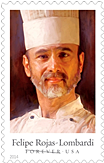
Renowned for his creativity and culinary adventurousness, Edward (Felipe) Rojas-Lombardi (1946–1991) is widely credited with introducing the Spanish small-plate tapas concept to American restaurants while raising the profile of Caribbean and South American cuisine.
Rojas-Lombardi was born and raised in Peru. His mother was Italian, and his father was a Chilean of Spanish and German descent who hoped his son would become a lawyer. When, as the first-born son, Rojas-Lombardi was sent to live in the home of his Chilean grandmother to learn the full range of family traditions, he marveled at her ability to prepare feasts for their large family.
In the late 1960s, after a stint in law school in Peru, Rojas-Lombardi moved to New York City, where he continued to study cooking and worked as the assistant to teacher and lecturer James Beard, who served as his mentor.
By the early 1970s, the breadth of Rojas-Lombardi’s culinary interests was becoming well known to the public. In addition to teaching and lecturing alongside James Beard, he also wrote a popular syndicated newspaper column about food. In 1972, he published The “A to Z No-Cook Cookbook,” an illustrated collection of recipes that included sandwiches, salads and other dishes for children to prepare, while also writing a booklet about the preparation of game meat.
In the late 1970s, he served as a consultant for the Ballroom, a New York City restaurant and cabaret, later becoming executive chef and owner. There he introduced New Yorkers to the concept of tapas, the appetizer-sized dishes commonly served as snacks in Spanish bars and cafés.
In the mid-1980s, Rojas-Lombardi appeared on the PBS series “New York’s Master Chefs,” where he put tapas before a nationwide audience. Inspired to imitate him, chefs across the United States transformed the Spanish bar-snack concept into small dinner plates intended for sharing. In 1985, Rojas-Lombardi published “Soup, Beautiful Soup,” a collection of more than 100 recipes inspired by the chef’s memories of eating soup before every lunch and dinner in Peru.
Around the time he died in 1991, American food-lovers greeted his book “The Art of South American Cooking,” an impressive and encyclopedic collection of recipes for soups, seafood, ceviches, empanadas, tamales and desserts that also offers vital tips on using cooking oils, making sauces and stocks and preparing seafood, produce, peppers, nuts and other specialized ingredients.
Customers may view many of this year’s other stamps on Facebook facebook.com/USPSStamps, Twitter@USPSstamps, Pinterest pinterest.com/uspsstamps, Instagraminstagram.com/uspostalservice or on uspsstamps.com,the Postal Service’s online site for information on upcoming stamp subjects, First-Day-Of-Issue events and other philatelic news.
First-Day-of-Issue Postmarks
Customers have 60 days to obtain the first-day-of-issue postmark by mail. They may purchase stamps at a local Post Office, The Postal Store at usps.com/stamps, or by calling 800-STAMP-24. Customers should affix the stamps to envelopes of their choice, address the envelopes to themselves or others, and place them in larger envelopes addressed to:
Celebrity Chefs
Retail Specialist
433 W Harrison Street
Chicago, IL 60699-9611
After applying the first-day-of-issue postmark, the Postal Service will return the envelopes through the mail. While the first 50 postmarks are free, there is a 5-cent charge per postmark beyond that. All orders must be postmarked by Nov. 26, 2014.
First-Day Covers
The Postal Service also offers first-day covers for new stamp issues and Postal Service stationery items postmarked with the official first-day-of-issue cancellation. Each item has an individual catalog number and is offered in the quarterly USA Philatelic catalog, online at usps.com/stamps or by calling 800-782-6724. Customers may request a free catalog by calling 800-782-6724 or writing to:
United States Postal Service Catalog Request
PO Box 219014
Kansas City, MO 64121-9014
Philatelic Products
Nine philatelic products are available for this stamp issue:
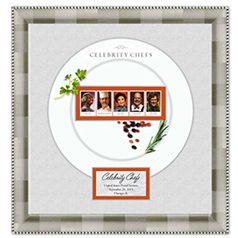
472324, Framed Art $39.95
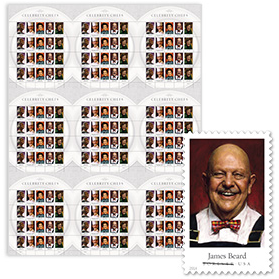
472306, Press Sheet with die cuts $88.20 (print quantity 1,000)
472308, Press Sheet without die cuts $88.20 (print quantity 1,500)
472310, Keepsake (Pane and Digital Color Postmark Set of 5), $18.95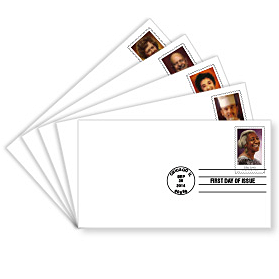
472316, First Day Cover Set of 5, $4.65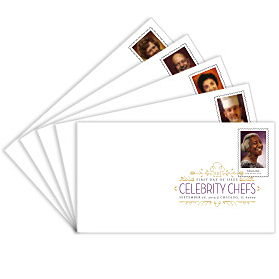
472321, Digital Color Postmark Set of 5, $8.20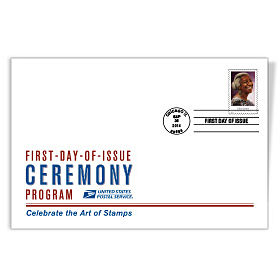
472330, Ceremony Program (random stamp), $6.95
472331, Stamp Deck Card, $0.95
472332, Stamp Deck Card with Digital Color Postmark (random stamp), $1.99
The Postal Service receives no tax dollars for operating expenses and relies on the sale of postage, products and services to fund its operations.
# # #
Please Note: For broadcast quality video and audio, photo stills and other media resources, visit the USPS Newsroom at about.usps.com/news/welcome.htm.
For reporters interested in speaking with a regional Postal Service public relations professional, please go to about.usps.com/news/media-contacts/usps-local-media-contacts.pdf.
Follow us on twitter.com/USPS and like us at facebook.com/USPS. For more information about the Postal Service, go to usps.com and usps.com/postalfacts.

